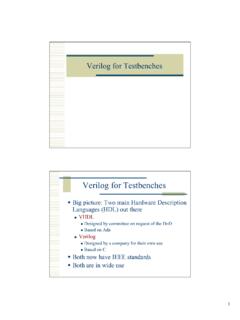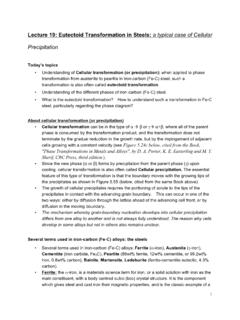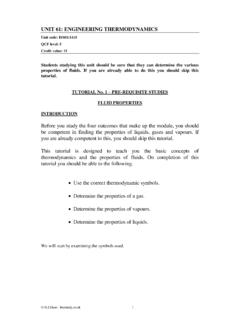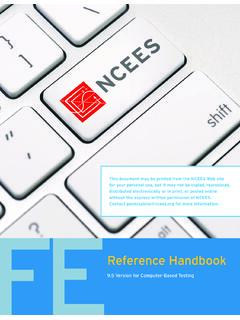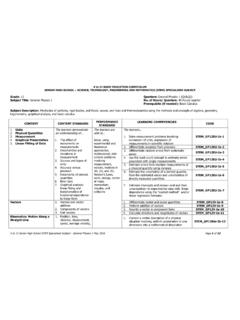Transcription of Engineering Equation Solver
1 E E S Engineering Equation Solver for Microsoft Windows Operating Systems Commercial and Professional Versions F-Chart Software email: Copyright 1992-2007 by Klein All rights reserved. The authors make no guarantee that the program is free from errors or that the results produced with it will be free of errors and assume no responsibility or liability for the accuracy of the program or for the results that may come from its use. EES was compiled with DELPHI 5 by Borland The three-dimensional plotting package is based on a modification of the public domain GLScene package ( ). The genetic optimization method implemented in EES is derived from the public domain Pikaia optimization program (version , April 2002) written by Paul Charbonneau and Barry Knapp at National Center for Atmospheric Research (NCAR) ( ). Registration Number_____ ALL CORRESPONDENCE MUST INCLUDE THE REGISTRATION NUMBER ii Table of Contents Table of Getting Started.
2 5 Installing EES on your Computer ..5 Starting EES ..5 Background Information ..6 An Example Thermodynamics Problem ..9 EES Windows ..23 General Information ..23 Equations Window ..25 Formatted Equations Solution Arrays Window ..33 Residuals Parametric Table Lookup Table Integral Table Diagram Window ..46 Development and Application Moving the Diagram ..48 Resizing the Diagram ..48 Adding and Moving Text on the Diagram Window ..48 Adding Graphic Items ..54 Selecting, Modifying and Aligning Text and Graphic Items ..55 Group and Ungroup Buttons ..55 Adding a Calculate Button ..56 Adding a Plot Window Access Button ..56 Creating Hot Areas and Child Diagram Windows (Professional Version only)..57 Saving User Inputs ..58 Creating Links (Professional Version) ..58 Adding a Help Button ..61 Navigating through Child Diagram Window (Professional Version) ..61 Adding a Print Button ..61 Adding an Audio-Visual Item ..62 Saving and Loading User Inputs (Professional Version).
3 63 -iii- Creating and Using Check Boxes (Professional Version) ..63 Creating and Using Radio Groups (Professional Version) ..65 Animation (Professional Version) ..66 Plot Moving the Plot ..70 Adding / Changing Text and Text Characteristics ..70 Moving Text ..73 Adding Lines and Arrows, Rectangles and Circles ..73 Moving Lines and Arrows, Rectangles and Circles ..74 Resizing the Modifying the Axis Information ..75 Aligning Items on the Plot Window ..79 Crosshairs ..79 3-D Plot Controls ..79 Report Window (Professional Version) ..83 Debug Window ..85 Incorrect Degrees of Freedom ..85 Constrained Solution ..86 Unit Checking Menu Commands ..88 The File Menu ..88 The Edit The Search Menu ..103 The Options The Calculate Menu ..123 The Tables The Plot Menu ..140 The Windows Menu ..152 The Help The Textbook Menu ..157 Built-in Functions ..159 Mathematical Functions ..159 CurveFit1D String Functions ..175 Thermophysical Property Functions.
4 177 Using Lookup Files and Lookup Tables ..187 Binary Lookup files (.LKT) ..187 ASCII Lookup files (.TXT)..187 ASCII Lookup files (.CSV)..188 Solid/Liquid Property Library ..194 ii Functions, Procedures, Modules, and EES Functions ..197 EES Procedures ..200 Single-Line If Then Else Multiple-Line If Then Else Statements ..203 GoTo Statements ..204 Repeat Until Statements ..204 Error Procedure ..205 Warning Print Command in Functions and Procedures ..207 Modules and Library Files ..212 External Functions and EES External Functions (.DLF files) ..215 The PWF Function a .DLF external routine in written in DELPHI ..217 SUM_C a .DLF external function written in Microsoft s Visual C++ ..221 EES External Procedures (.FDL and .DLP files) ..222 External Procedures with the .FDL Format - a FORTRAN External Procedures with the .DLP Format - a Pascal Example ..225 External Procedures with the .DLP Format - a C++ Example ..227 Multiple Files in a Single Dynamic Link Library (.)
5 DLL)..229 Help for External Functions and Library Manager (Professional Version)..234 Advanced Features ..235 String Complex Variables ..236 Array Variables ..240 The DUPLICATE Command ..242 Matrix Capabilities ..243 Using the Property Plot ..245 Integration and Differential Equations ..246 Method 1: Solving Differential Equations with the Table-Based Integral Function ..248 Method 2: Use of the $Integral Directive and the Equation -Based Integral Method 3: Solving Differential Equations with the TableValue Function ..254 Directives ..259 $ARRAYS On/Off Directive ..259 $CHECKUNITS On/Off/AutoOn/AutoOff ..259 $COMMON $COMPLEX On/Off Directive ..260 $CONSTANT Name# = ValueSI [UnitsSI] ValueEng [UnitsEng] ..260 $DOLAST and $ENDDOLAST Directives ..261 -iii- $EXPORT Directive ..261 $IF/IFNOT Directives ..263 $IMPORT Directive ..265 $INCLUDE Directive ..266 $INTEGRALTABLE Directive ..267 $LOCALVARIABLES On/Off $OPENLOOKUP Directive.
6 268 $PRIVATE Directive ..269 $REAL $REQUIREDOUTPUTS $REFERENCE Directive ..269 $SAVELOOKUP Directive ..270 $ $SHOWWINDOW WindowName ..271 $SUMROW On/Off Directive ..272 $TABWIDTH $TRACE Directive ..273 $TRACE allows the values of selected variables to be recorded during the process in which the equations are iteratively solved. The format $Trace x, y, z ..273 where x, y, and z are variables for which an iteration to iteration trace is $UNITSYSTEM $WARNINGS On/Off Directive ..273 Creating and Using Macro Files (Professional Version)..274 Unit Lists ..284 Creating Entries to the Visual Libraries ..286 Hints for Using Numerical Methods Used in EES ..293 Solution to Algebraic Equations ..293 Blocking Equation Sets ..296 Determination of Minimum or Maximum Values ..298 Numerical Integration ..299 References ..301 Adding Property Data to EES ..303 Background Information ..303 Adding Fluid Properties to EES ..305 SAMPLE SAMPLE File for pure fluids.
7 307 1 _____ Overview _____ EES (pronounced 'ease') is an acronym for Engineering Equation Solver . The basic function provided by EES is the solution of a set of algebraic equations. EES can also solve differential equations, equations with complex variables, do optimization, provide linear and non-linear regression, generate publication-quality plots, simplify uncertainty analyses and provide animations. EES has been developed to run under 32-bit Microsoft Windows operating systems, , Windows 95/98/2000/XP. It can be run in Linux and on the Macintosh using emulation programs. There are two major differences between EES and existing numerical Equation -solving programs. First, EES automatically identifies and groups equations that must be solved simultaneously. This feature simplifies the process for the user and ensures that the Solver will always operate at optimum efficiency.
8 Second, EES provides many built-in mathematical and thermophysical property functions useful for Engineering calculations. For example, the steam tables are implemented such that any thermodynamic property can be obtained from a built-in function call in terms of any two other properties. Similar capability is provided for most organic refrigerants (including some of the new blends), ammonia, methane, carbon dioxide and many other fluids. Air tables are built-in, as are psychrometric functions and JANAF table data for many common gases. Transport properties are also provided for most of these substances. The library of mathematical and thermophysical property functions in EES is extensive, but it is not possible to anticipate every user's need. EES allows the user to enter his or her own functional relationships in three ways. First, a facility for entering and interpolating tabular data is provided so that tabular data can be directly used in the solution of the Equation set.
9 Second, the EES language supports user-written Functions and Procedures similar to those in Pascal and FORTRAN. EES also provides support for user-written routines, which are self-contained EES programs that can be accessed by other EES programs. The Functions, Procedures, Subprograms and Modules can be saved as library files which are automatically read in when EES is started. Third, external functions and procedures, written in a high-level language such as Pascal, C or FORTRAN, can be dynamically-linked into EES using the dynamic link library capability incorporated into the Windows operating system. These three methods of adding functional relationships provide very powerful means of extending the capabilities of EES. 2 The motivation for EES rose out of experience in teaching mechanical Engineering thermodynamics and heat transfer. To learn the material in these courses, it is necessary for the student to work problems.
10 However, much of the time and effort required to solve problems results from looking up property information and solving the appropriate equations. Once the student is familiar with the use of property tables, further use of the tables does not contribute to the student's grasp of the subject; nor does algebra. The time and effort required to do problems in the conventional manner may actually detract from learning of the subject matter by forcing the student to be concerned with the order in which the equations should be solved (which really does not matter) and by making parametric studies too laborious. Interesting practical problems that may have implicit solutions, such as those involving both thermodynamic and heat transfer considerations, are often not assigned because of their mathematical complexity. EES allows the user to concentrate more on design by freeing him or her from mundane chores.

